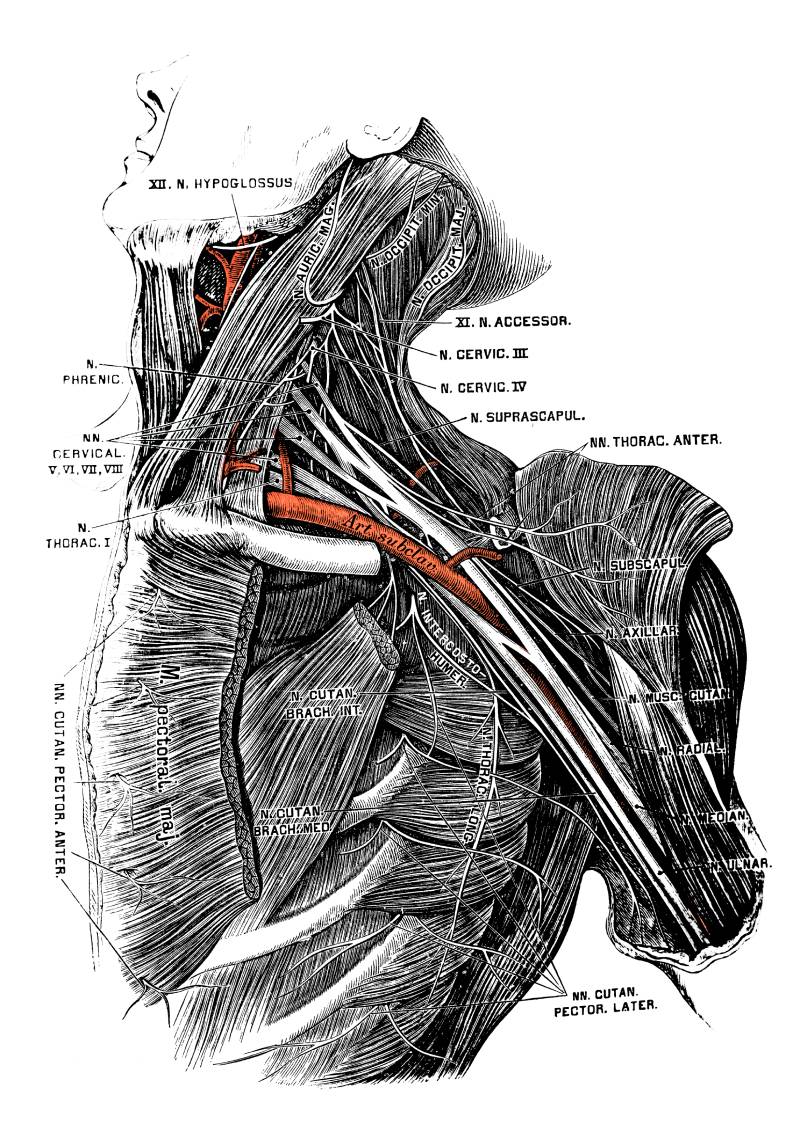The brachial plexus block is an essential tool employed by anesthesiologists and pain specialists to provide anesthesia and analgesia from the shoulder to the hands and fingertips (Pester, et al., 2023). The brachial plexus consists of the C5 to T1 nerve roots, with one plexus on each side of the body, which proceed to form trunks, divisions, cords, and terminal branches while innervating the upper limb (Ranganath et al., 2014). The brachial plexus block plays a pivotal role in postoperative pain management (Pester, et al., 2023). To optimize patient care, healthcare professionals must understand the diverse types of brachial plexus block. These can vary by anatomical approach, the necessity for ultrasound, and the choice of anesthetic agent. The primary types of brachial plexus block include interscalene, superior trunk, supraclavicular, infraclavicular and axillary blocks (Ranganath et al., 2014).
The interscalene brachial plexus block entails the injection of local anesthetic into the interscalene groove, rendering it effective for surgical procedures involving the shoulder, clavicle, and upper arm. Nevertheless, it is important to be mindful of potential complications, such as diaphragmatic weakness, as the interscalene approach is in close proximity to the phrenic nerve (Mojica, et al., 2022).
The supraclavicular brachial plexus block involves the injection of anesthesia superior to the clavicle. This approach offers analgesia from the mid-humerus to the fingertips and offers a lower risk of phrenic nerve blockade compared to the interscalene block. This procedure carries an elevated risk of pneumothorax due to its proximity to the lungs and the potential for subclavian artery puncture (Pester, et al., 2023).
The infraclavicular block is a valuable technique for procedures on the forearm, wrist, and hand, providing analgesia from the mid-humerus to the fingertips (Guo et al., 2023). The approach can be executed via a traditional approach or a retro clavicular approach (Pester, et al., 2023). Notably, the use of ultrasound significantly reduces the risk of diaphragmatic paralysis or pneumothorax. However, complications may include injury to the brachial plexus and axillary vessels (Guo et al., 2023).
Other types of brachial plexus block include the axillary block. This targets the terminal branches of the brachial plexus, providing anesthesia for the entire upper limb from the mid-humerus to the fingertips (Pester, et al., 2023). This approach carries a minimal risk of causing pneumothorax. Nevertheless, practitioners should exercise caution to avoid puncturing any blood vessels in this highly vascular area.
The integration of ultrasound in healthcare has revolutionized nerve blocks and anesthesia. Ultrasound-guided blocks enhance needle placement accuracy and facilitate identification of both brachial plexus structures and vascular components, including arteries and veins, thereby enhancing safety and efficacy (Guo et al., 2023). Some contraindications to the brachial plexus block include allergy to anesthetic or active infection such as cellulitis or an abscess at the site of the block. Other contraindications to brachial plexus block are specific to the anatomical approach utilized (Guo et al., 2023).
Comprehensive knowledge of the diverse types and approaches to brachial plexus block is vital in the fields of anesthesiology and pain management. Each block has unique advantages and disadvantages, and understanding these approaches is pivotal for ensuring optimal patient comfort and care.
References
Guo, Zhimin et al. “Ultrasound-guided brachial plexus block at the clavicle level: A review.” Drug discoveries & therapeutics vol. 17,4 (2023): 230-237. doi:10.5582/ddt.2023.01005
Mojica, Jeffrey J et al. “Anesthesia for the Patient Undergoing Shoulder Surgery.” Clinics in sports medicine vol. 41,2 (2022): 219-231. doi:10.1016/j.csm.2021.11.004
Pester, John M, et al. “Brachial Plexus Block Techniques – Statpearls – NCBI Bookshelf.” National Library of Medicine , StatPearls Publishing, 4 Aug. 2023, www.ncbi.nlm.nih.gov/books/NBK470213/.
Ranganath, Anil et al. “Ultrasound guided axillary brachial plexus block.” Medical ultrasonography vol. 16,3 (2014): 246-51. doi:10.11152/mu.2013.2066.163.2kks
